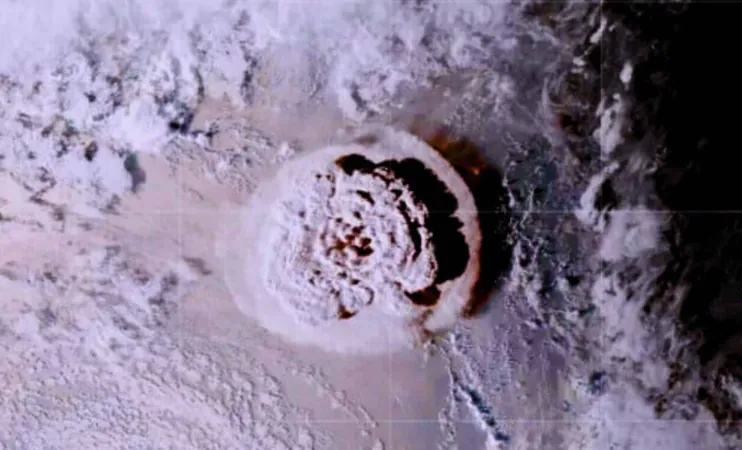
A Blink Before Disaster: The Seismic Wave That Predicted a Volcanic Eruption
2025-01-02
Author: Ming
The Hunga Tonga Eruption: A Historical Geological Event
On January 15, 2022, the Hunga Tonga-Hunga Ha'apai volcano erupted in the South Pacific near Tonga, marking it as one of the largest underwater explosions ever recorded. The eruption annihilated the volcanic island itself and resulted in significant destruction across coastal regions. Reports suggest that the explosion generated sounds so loud that they reverberated globally, making it the loudest natural phenomenon in over a century.
The eruption produced an astounding plume of ash, gas, and water vapor that soared over 30 kilometers into the stratosphere. This unprecedented event injected an estimated 150 million tons of water vapor into the atmosphere, radically altering its chemistry. The massive influx of water vapor enabled the rapid formation of sulfate aerosols—particles that are crucial in climate processes—while also leading to extensive ozone layer depletion.
Key Statistics from the Eruption:
- Plume Height: Over 30 kilometers, ranking among the tallest ever recorded. - Water Vapor Released: 150 million tons, significantly impacting stratospheric chemistry. - Global Consequences: The eruption contributed to record-high global temperatures for 2022.
In Tonga, the situation was dire. Ashfall contaminated water supplies and displaced tens of thousands of residents, while tsunami waves generated by the eruption wreaked havoc across the Pacific, affecting countries as distant as New Zealand, Japan, and parts of the United States.
The Seismic Wave: A Silent Messenger of Doom
Before the massive eruption, scientists detected a peculiar seismic anomaly known as a Rayleigh wave. These waves, which typically ripple along the Earth's surface, have now been linked to large-scale underwater volcanic activity for the first time. Detected by distant sensors in Fiji and Futuna over 750 kilometers away, this wave silently traveled through the Earth's crust approximately 15 minutes prior to the eruption.
This groundbreaking finding offers an invaluable opportunity for volcanic research. The Rayleigh wave was produced by the rapid collapse of the volcano's caldera coupled with abrupt interactions of magma and seawater. Although invisible to the human senses, these seismic signals could serve as crucial precursors to volcanic eruptions, potentially allowing for timely evacuations.
Dr. Mie Ichihara, a volcanologist from the University of Tokyo, emphasized the significance of this discovery, stating, "This wave is like a messenger. If we learn to listen to it, we might be able to predict the unpredictable."
Atmospheric Changes: A New Era for Volcanology
The Hunga Tonga eruption had profound atmospheric implications that changed conventional understandings of volcanic behavior. Instead of the typical sulfur dioxide emissions, this eruption predominantly released water vapor, driving an accelerated formation of aerosols. The involvement of such a massive water vapor injection led to aerosol production at a rate three times faster than typical volcanic eruptions, creating a colossal layer of sulfate aerosols that has implications for global climate.
Notable Atmospheric Effects:
- Aerosol Formation Rate: Increased to three times the usual speed due to water vapor. - Ozone Depletion: Immediate reductions of up to 30%, with lingering effects.
A Bright Spot: Implications for Future Preparedness and Climate Science
The insights gained from the Hunga Tonga eruption signify a pivotal moment for both disaster preparedness and climate research. The detection of the Rayleigh wave holds promise for enhancing seismic monitoring efforts to predict underwater eruptions effectively. Real-time identification of such waves could grant communities vital minutes for alerts and evacuations, especially in vulnerable regions like Tonga.
Moreover, the eruption emphasizes the crucial relationship between large-scale volcanic events and global climate systems. As these eruptions inject considerable volumes of aerosols and greenhouse gases, they challenge scientists to refine their climate models and explore geoengineering possibilities. This intriguing field of study involves deliberate atmospheric alterations to mitigate climate change, highlighting the ever-evolving intersection of volcanology and environmental science.
This significant research was published in the Proceedings of the National Academy of Sciences, promising new horizons for understanding and predicting natural disasters. Are you ready for the next volcanic event? Stay informed and prepared!
 Brasil (PT)
Brasil (PT)
 Canada (EN)
Canada (EN)
 Chile (ES)
Chile (ES)
 Česko (CS)
Česko (CS)
 대한민국 (KO)
대한민국 (KO)
 España (ES)
España (ES)
 France (FR)
France (FR)
 Hong Kong (EN)
Hong Kong (EN)
 Italia (IT)
Italia (IT)
 日本 (JA)
日本 (JA)
 Magyarország (HU)
Magyarország (HU)
 Norge (NO)
Norge (NO)
 Polska (PL)
Polska (PL)
 Schweiz (DE)
Schweiz (DE)
 Singapore (EN)
Singapore (EN)
 Sverige (SV)
Sverige (SV)
 Suomi (FI)
Suomi (FI)
 Türkiye (TR)
Türkiye (TR)
 الإمارات العربية المتحدة (AR)
الإمارات العربية المتحدة (AR)